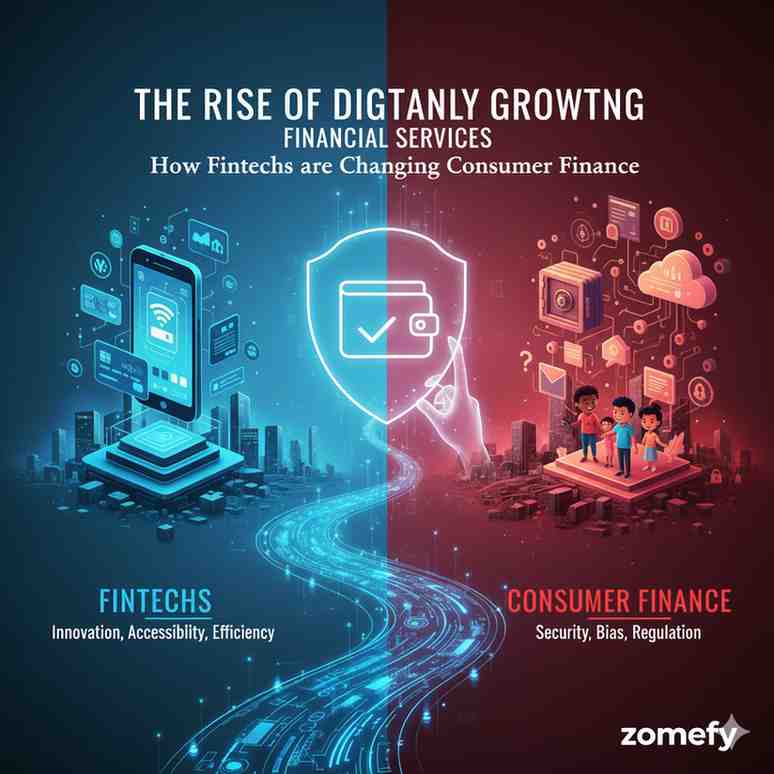Challenger Banks: Expanding Beyond Borders and Products
Assess how digital-first challenger banks are broadening their product lines and launching in new markets despite regulatory and competitive hurdles.
Challenger Banks: Expanding Beyond Borders and Products
What You Can Do Next
- Read the full article for complete insights
- Save for later reference
- Share with others learning about this topic
Image not available
Challenger banks, also known as neobanks, are revolutionizing the financial services landscape by expanding beyond their initial digital-only offerings to become comprehensive financial platforms. These innovative institutions are not only broadening their product lines but also launching in new markets, challenging traditional banking models and regulatory frameworks. This comprehensive analysis explores how challenger banks are evolving, their expansion strategies, the challenges they face, and the transformative impact on global financial services.
The Evolution of Challenger Banks
Challenger banks have evolved from simple digital payment platforms to comprehensive financial services providers, offering a wide range of products and services that compete directly with traditional banks.
From Simple to Sophisticated
Early challenger banks focused on basic checking accounts and payment services. Modern challenger banks offer comprehensive financial services including lending, investment products, insurance, and business banking solutions.
Technology Integration
Challenger banks leverage cutting-edge technologies like AI, machine learning, and blockchain to provide personalized services, automated processes, and innovative financial products.
Product Line Expansion
Challenger banks are rapidly expanding their product offerings to compete with traditional banks:
Lending and Credit Products
Many challenger banks now offer personal loans, credit cards, mortgages, and business loans, using AI-powered underwriting and risk assessment to provide faster, more accurate lending decisions.
Investment and Wealth Management
Challenger banks are entering the investment space with robo-advisors, commission-free trading, cryptocurrency services, and automated portfolio management tools.
Insurance Products
Some challenger banks are partnering with insurance companies or developing their own insurance products, including travel insurance, device protection, and life insurance.
Business Banking Solutions
Challenger banks are expanding into business banking with business accounts, payment processing, invoicing tools, and financial management software for small and medium enterprises.
Geographic Expansion Strategies
Challenger banks are pursuing various strategies to expand into new markets:
Regulatory Partnerships
Many challenger banks partner with established financial institutions in new markets to navigate regulatory requirements and gain market access without full banking licenses.
Licensing and Regulatory Compliance
Some challenger banks are obtaining full banking licenses in new jurisdictions, enabling them to offer comprehensive financial services and compete directly with traditional banks.
Acquisition and Merger Strategies
Challenger banks are acquiring local fintech companies and traditional banks to quickly establish market presence and gain regulatory approval in new markets.
API-First Expansion
Some challenger banks are expanding through API partnerships, allowing them to offer their services through third-party platforms and applications in new markets.
Technology and Innovation
Challenger banks are leveraging advanced technologies to differentiate themselves:
Artificial Intelligence and Machine Learning
AI-powered chatbots, personalized financial advice, fraud detection, and automated customer service are becoming standard features of challenger banks.
Open Banking and APIs
Challenger banks are embracing open banking principles, providing APIs that allow third-party developers to create innovative financial applications and services.
Blockchain and Cryptocurrency
Many challenger banks are integrating cryptocurrency services, blockchain-based payments, and digital asset management into their platforms.
Mobile-First Design
Challenger banks prioritize mobile user experience, offering advanced mobile banking features, biometric authentication, and location-based services.
Regulatory Challenges and Compliance
Challenger banks face significant regulatory challenges as they expand:
Cross-Border Regulatory Complexity
Operating in multiple jurisdictions requires compliance with different regulatory frameworks, creating complexity and increasing operational costs.
Licensing Requirements
Obtaining banking licenses in new markets can be time-consuming and expensive, requiring significant capital and regulatory expertise.
Data Privacy and Security
Challenger banks must comply with various data protection regulations, including GDPR in Europe and similar laws in other jurisdictions.
Anti-Money Laundering (AML) Compliance
Challenger banks must implement robust AML and KYC procedures across all markets, requiring significant investment in compliance technology and personnel.
Competitive Landscape and Market Dynamics
Challenger banks face intense competition from various players:
Traditional Bank Response
Traditional banks are investing heavily in digital transformation, launching their own digital banking platforms and acquiring fintech companies to compete with challenger banks.
Big Tech Competition
Technology giants like Apple, Google, and Amazon are entering financial services, creating new competitive pressures for challenger banks.
Fintech Specialists
Specialized fintech companies focusing on specific financial services are competing with challenger banks for market share and customer attention.
Regulatory Sandboxes
Regulatory sandboxes in various jurisdictions are enabling new players to enter the market, increasing competition and innovation in the financial services sector.
Customer Acquisition and Retention
Challenger banks are developing innovative strategies to acquire and retain customers:
Digital Marketing and Social Media
Challenger banks leverage digital marketing, social media, and influencer partnerships to reach younger, tech-savvy customers who prefer digital financial services.
Referral Programs and Incentives
Many challenger banks offer referral bonuses, cashback rewards, and other incentives to attract new customers and encourage existing customers to refer friends and family.
Partnership and Integration
Challenger banks partner with popular apps and services to integrate their financial services, making banking more convenient and accessible to customers.
Personalization and AI
AI-powered personalization helps challenger banks provide tailored financial advice and products, improving customer satisfaction and retention.
Challenges and Risks
Challenger banks face several significant challenges:
Regulatory Uncertainty
Evolving regulatory frameworks and uncertainty about future regulations can create challenges for challenger banks planning long-term expansion strategies.
Capital Requirements
Expanding into new markets and offering comprehensive financial services requires significant capital investment, which can be challenging for smaller challenger banks.
Technology and Security
Maintaining robust technology infrastructure and cybersecurity measures across multiple markets requires significant investment and expertise.
Customer Trust and Brand Recognition
Building trust and brand recognition in new markets can be challenging, especially when competing with established traditional banks.
Future Outlook: The Challenger Bank Revolution
The future of challenger banks looks promising, with several key trends emerging:
Super App Development
Challenger banks are evolving into super apps that offer a wide range of financial and non-financial services, creating comprehensive digital ecosystems for customers.
Embedded Finance
Challenger banks are integrating their services into other platforms and applications, making financial services more accessible and convenient for customers.
Sustainability and ESG
Many challenger banks are incorporating environmental, social, and governance (ESG) principles into their business models and product offerings.
Global Standardization
Efforts to standardize regulatory requirements and financial services across jurisdictions will make it easier for challenger banks to expand globally.
Conclusion
Challenger banks are transforming the financial services landscape by expanding beyond their initial digital-only offerings to become comprehensive financial platforms. Their success depends on their ability to navigate regulatory challenges, compete with traditional banks and big tech companies, and provide innovative, customer-centric financial services. As they continue to expand globally and broaden their product offerings, challenger banks are likely to play an increasingly important role in the future of financial services, driving innovation and improving access to financial services for customers worldwide.
To understand how challenger banks intersect with broader fintech trends, explore our analysis on [AI's role in financial services](/financial-insights/ai-finance-growth-opportunities-2025) and the [digital banking revolution](/financial-insights/digital-only-banking-fintech-2025). For insights into the underlying blockchain technology, read our [Crypto 2025 analysis](/financial-insights/crypto-2025-blockchain-ai-tokenization).
Frequently Asked Questions
What are challenger banks and how do they differ from traditional banks?
Challenger banks are digital-first financial institutions that operate primarily through mobile apps and online platforms, without physical branches. They focus on user experience, technology innovation, and customer-centric services, often offering lower fees and more convenient banking experiences compared to traditional banks.
How are challenger banks expanding their product offerings?
Challenger banks are expanding beyond basic banking services to offer comprehensive financial products including lending, investment services, insurance, business banking, and cryptocurrency services, often using AI and automation to provide personalized and efficient services.
What challenges do challenger banks face when expanding globally?
Key challenges include navigating different regulatory frameworks across jurisdictions, obtaining banking licenses, complying with local data protection laws, building brand recognition in new markets, and competing with established traditional banks and local fintech companies.
How do challenger banks compete with traditional banks and big tech companies?
Challenger banks compete through superior user experience, lower fees, faster service, innovative technology, personalized financial advice, and by focusing on specific customer segments. They also leverage partnerships and integrations to expand their reach and offer comprehensive financial ecosystems.
References
- [1] Ten Technologies Shaping the Future of Fintech in 2023 - DashDevs. View Source ↗(Accessed: 2025-10-14)
- [2] Fintech Trends 2025 - Plaid. View Source ↗(Accessed: 2025-10-14)
- [3] The Future of Global Fintech 2025 - World Economic Forum. View Source ↗(Accessed: 2025-10-14)
- [4] Pulse of Fintech - KPMG. View Source ↗(Accessed: 2025-10-14)
- [5] Fintech Trends - HyperVerge. View Source ↗(Accessed: 2025-10-14)
- [6] Top 10 Fintech Payments Trends 2025 - Juniper Research. View Source ↗(Accessed: 2025-10-14)
- [7] Fintech Trends - Innowise. View Source ↗(Accessed: 2025-10-14)
- [8] Fintechs: Scaled Winners and Emerging Disruptors - BCG. View Source ↗(Accessed: 2025-10-14)
- [9] Fintech Trends 2025 - Lloyds Banking Group. View Source ↗(Accessed: 2025-10-14)
- [10] Top Fintech Trends - KPMG. View Source ↗(Accessed: 2025-10-14)
Continue Your Investment Journey
Discover more insights that match your interests

The Rise of Digital-Only Banking: How Fintechs are Changing Consumer Finance
Detail the rapid shift toward branchless, digital banking institutions, focusing on benefits, security innovations, and the future of retail banking.

Fei USD and the Rise of Algorithmic Stablecoins: 2025 Investment Implications
Algorithmic stablecoins have emerged as a significant innovation in the cryptocurrency space by offering decentralized, scalable alternatives to traditional fiat-backed stablecoins.

Support and Resistance Trading: Complete Strategy Guide for Indian Markets
Master support and resistance trading with horizontal levels, trendlines, and volume confirmation strategies for Indian markets.

Deeptech Unicorns 2025: How Defence, Robotics, and Energy Startups Are Reshaping Investment Valuations
India's startup ecosystem is undergoing a profound transformation, with deep tech—encompassing defence, robotics, and energy—emerging as a key driver of innovation and investment.
Explore More Insights
Continue your financial education journey
